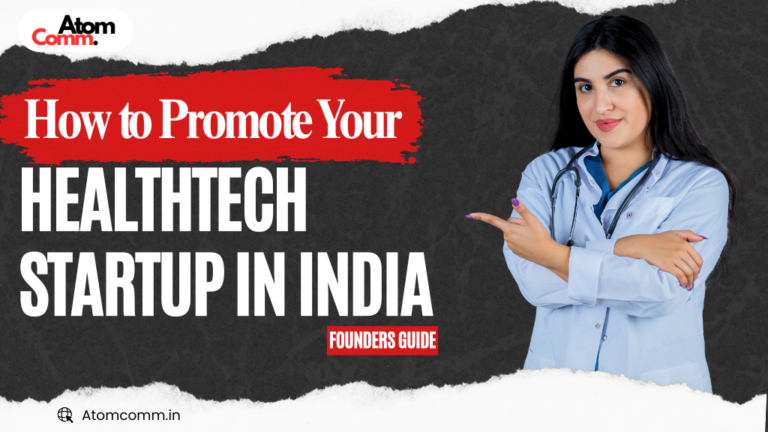How to Promote Your Healthtech Startup in India | Founders Guide

India’s healthtech industry is poised for rapid expansion, with projections estimating a market value of over $50 billion by 2030. But building a great product is only half the battle — making sure the right people know about it is what drives traction and trust.
Whether you’re creating AI diagnostic tools, telemedicine platforms, health tracking apps, or B2B SaaS for hospitals, a strategic marketing approach is critical. Here’s how you can effectively promote your healthtech startup in India.
1. Start with Thought Leadership PR
In a sensitive domain like healthcare, credibility is currency. Earned media coverage in publications like Economic Times Healthworld, Inc42, YourStory, or Business Standard creates visibility and trust.
- Pitch stories around innovation, public impact, or health access.
- Share industry insights, not just product updates.
- Place your founder as a subject-matter expert with media columns or panel invitations.
Example: Practo’s rise was fuelled by both product growth and their regular presence in national media explaining the future of telehealth.
2. Build Doctor & Patient Trust Through Testimonials
For B2C and B2B2C healthtech startups, word-of-mouth from real users and experts is invaluable. Launch pilot programs or case studies with hospitals, doctors, and users — then amplify those stories on:
- YouTube explainers
- Medium blogs
- Regional language platforms (for Tier 2+ users)
3. Go Beyond Ads — Leverage Educational Content
Google’s health-related search traffic in India exceeds 600 million monthly queries. Healthtech brands should create educational content, not just promotional messaging.
Use SEO-optimized blogs, YouTube videos, and social media posts to talk about:
- Health awareness
- How your product solves everyday health problems
- Preventive care tips
- How your tech improves health access
Pro tip: Ensure all medical content is fact-checked or reviewed by certified professionals to build long-term credibility.
4. Build Strategic B2B Partnerships
If your product serves hospitals, labs, clinics, or wellness chains, use direct outreach and partnerships over ads. Focus on:
- Attending industry expos like India Health or BioAsia
- Featuring in healthcare newsletters like HealthCare Radius
- Cold-emailing decision-makers with case studies
A single institutional client in healthtech can be more valuable than 1,000 app downloads.
5. Invest in SEO for Long-Term Discovery
Health is a high-intent search category. Ranking for keywords like:
- “Telemedicine platforms in India”
- “AI for radiology in India”
- “HIPAA-compliant software for clinics”
…can bring sustained organic leads. Optimize your landing pages, technical SEO, and blog structure around E-E-A-T (Experience, Expertise, Authoritativeness, Trustworthiness) — crucial for health-related content.
Book your free 20-minute SEO strategy call — no strings attached.
6. Localize Your Messaging for Tier 2 and 3 Markets
India’s next billion users don’t all read English — or trust English-only brands. Make sure your messaging is:
- Available in Hindi and major regional languages
- Tailored to the cultural and healthcare concerns of smaller cities
- Disseminated via platforms like ShareChat, Moj, or regional YouTube channels
7. Get Listed on Healthtech Directories and Platforms
Visibility in relevant ecosystems drives inbound leads. Get listed or featured on:
- NASSCOM Healthtech special reports
- Startup India HealthTech Showcase
- AngelList, Crunchbase, and Tracxn
- YourStory Tech30 or LinkedIn India Top Startups lists
These not only bring credibility but also media and investor attention.
8. Comply with Regulations and Highlight It
The Indian healthtech space is becoming more regulated. Highlight your startup’s:
- Data privacy and HIPAA or DISHA compliance
- Medical approvals (if applicable)
- Ethical health practices
Trust is hard-won in this space — being transparent builds it faster.
Marketing healthtech startups isn’t about just being visible — it’s about being useful, credible, and trusted. PR, content, and partnerships go a long way when combined with regulatory transparency and patient-centric communication.
